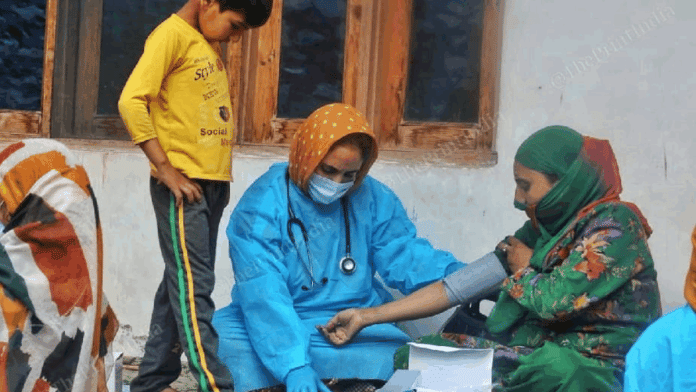New Delhi/Chennai: The top epidemiology institute in India is in the process of rolling out a crucial initiative to fill the gaps in the management of diabetes, as well as hypertension, as the lifestyle conditions reach higher levels than earlier in the country.
A large study published in 2023 and carried out by the Indian Council of Medical Research (ICMR), jointly with the Madras Diabetes Research Foundation (MDRF), showed that there are 31.5 crore people with hypertension, along with 10.1 crore diabetics, in India.
Fewer than 10 percent of people with hypertension had blood sugar under control in 2019-21. Fewer than 66 percent of the diabetics had the metabolic disorder under control during the same period.
So, the ICMR-National Institute of Epidemiology (ICMR-NIE), as an extension of the National Programme for prevention and control of Non Communicable Diseases (NP-NCD), will now employ quality improvement (QI) strategies to improve treatment outcomes for those with hypertension and diabetes, two leading lifestyle disorders in India.
Hypertension, also known as high blood pressure, is a condition where the force of blood against the artery walls is consistently too high. Left untreated for long, the condition, called a ‘silent killer’, could lead to serious health complications, including heart attack, stroke, kidney disease, and vision loss.
The common form of diabetes in India is Type 2 diabetes, mainly triggered by insulin resistance, often combined with relatively reduced secretion of insulin, leading to poor absorption of glucose from blood and linked with lifestyle issues, such as inadequate dietary habits and a lack of physical activity.
These disorders afflicted mainly the urban populations, earlier. Now, their penetration among the rural masses is also growing fast.
Scientists associated with the project stated that the control of blood pressure and blood sugar—among those treated for the two conditions—could be affected due to gaps on the patients’ side, such as a lack of adherence, poor follow-up visits, or provider-related issues, including therapeutic inertia. The gaps can also be caused by systemic issues, including inadequate resources or improper documentation.
To begin with, ICMR-National Institute of Epidemiology (ICMR-NIE) Director Dr Manoj Murhekar and other researchers now plan to embed quality improvement (QI) strategies within existing care, as provided under the NP-NCD programme in some selected districts of Goa, Telangana, and Punjab.
Accordingto details shared by him and other scientists, the implementation model will help establish QI teams at government primary care facilities, primary health centres, and health and wellness centres; and build the capacity of the health workforce to identify quality gaps that require prioritising, find out the root causes, and address them through simple and sustainable interventions.
For the incorporation of these strategies within the routine programme settings, the institute would present its findings to the ICMR as well as the Union health ministry, but only if the findings indicate that successful implementation of the QI project is possible under local district QI teams with improved treatment outcomes following their work, epidemiologists associated with the plan told ThePrint.
Customised interventions
Currently, scientists are collecting baseline data to understand the priority quality gaps that need addressing at different facilities.
The next phase will involve the formation and training of local QI teams, and after that, each team will initiate projects to address priority local gaps, with the support of the ICMR-NIE team—something the India Hypertension Control Programme (IHCI) has implemented in more than 100 districts across India.
“We strongly felt quality improvement can be done after streamlining of basic services,” said ICMR-NIE scientist Dr Archana R, a key member of the project.
The scientists selected two states, where, from 2018-19, the HCI was under implementation—Telangana and Punjab—in the southern and northern regions of India, respectively. Goa represented an urbanised state with a high per capita income.
“Thus, the project will gain insights into what works in which places, and therefore, we can learn valuable lessons for integration with the National Program in different regions,” Archana said.
The interventions may undergo customisation based on the root causes of the problem at specific sites.
Earlier, the institute conducted a QI project in Seoni, Madhya Pradesh, to improve regular follow-up visits among patients with hypertension. It found ASHAs (Accredited Social Health Activists), who were supposed to pay home visits to motivate people for follow-up visits, did not turn up at every home, as the guidelines required them.
The main reasons included not providing an updated line list of the persons registered with hypertension or supervising the ASHAs, or the staff nurses, in charge of overseeing them, maintaining no records of the home visits by the ASHAs.
The workers did not receive incentives for home visits on time, leading to demotivation and dissatisfaction, the researchers found.
In response, the interventions introduced included the staff nurses providing an updated line list of the persons registered with hypertension to the ASHAs, as well as maintaining accurate records of their home visits and tracking them to see if workers were providing patients incentives, as instructed.
The results included a twofold increase in the follow-up percentages from their baseline, and the return of more than 50 percent of the registered patients for follow-up care. This change, in turn, improved BP control throughout the post-intervention period—22 percent from baseline to more than 50 percent.
(Edited by Madhurita Goswami)
Also Read: Eli Lilly announces trial results for world’s 2nd weekly insulin, aims for launch by year-end






